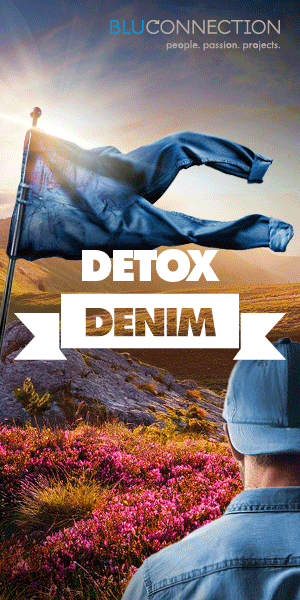Mission and vision

Katrin Ley has headed Fashion for Good since its founding. Six years on, she says it is a turning point and ready to take on a second stage of its development. The Amsterdam-based non-profit organisation is on a mission to inspire and drive sustainability in the apparel industry. Through its innovation platform, it has been selecting and incubating countless start-ups proposing novel solutions at all levels of the supply chain, from fibre to process to digital tracking.
Q: Many of the research projects set up by Fashion for Good bring together companies from all stages of the supply chain, and collaboration is arguably fundamental to developing and scaling new technologies. How easy, or difficult, has it been to convince companies to pool their resources to work together?
A: From the very foundation of Fashion for Good, we designed it to be a space for pre-competitive collaboration. This is not uncommon in the world of sustainability, but it is not so common in the field of innovation, which companies often consider a key differentiation point. I think we’ve been able to prove that there is a real benefit in working together and that it makes sense to collaborate when taking on challenging projects that are risky and R&D heavy, as is any new technology related to circularity. Companies understand that it makes business sense to work together for the more challenging projects but it makes collaboration that much more difficult because we are bringing together corporations that are inherently risk-averse with start-ups that are by nature risk-prone.
The digital concepts are usually easier to set up, such as Textile Genesis’ digital tracing solution which Fashion for Good supported four years ago. It covered the entire supply chain from fibre to finished product and involved Kering, Bestseller and three viscose producers. Its goal was to prove the interoperability of Textile Genesis’ solution.
We have found the denim industry, which is a key area of focus for us, to be relatively open to collaboration. Projects in this field have covered the entire supply chain, from machinery suppliers such as Tonello and Jeanologia to brands, including Levi’s, PVH, as well as suppliers. Candiani, Saitex, Artistic Milliners, Soorty and Stony Creek, to name a few, are some of the companies that have participated in Fashion for Good projects.
Among all the projects supported by Fashion for Good since it launched, what has been their success rate, if that concept applies to these endeavours?
We first strive, of course, to select the most promising companies and have scouted 2,500 innovators, of these 160 start-ups have gone through the Fashion for Good programme and one-third have been implemented. Our platform has also led to the launch of 326 pilot projects. Through this, we have made it possible to evaluate these technologies, their cost-competitiveness and verify that they have a positive impact. Among the 160 projects that have been incubated, not all have reached industrial scale, but many have been able to access recurring or continuous business. Infinited Fiber has been able to attract commitments to buy from a major fashion retailer, Inditex, the owner of Zara. PVH, Zalando and Adidas are other corporations that have made definitive commitments to some of our projects.
Have you found that there is a recipe for success that makes some projects take off?
We have found that it is fundamentally a function of time. Developing a new technology takes time, and with time, it reaches a tipping point. In the first five years of our activity, we have helped create that space for innovative companies. Now, as we move on to the next five years, we are looking to scale the projects we back.
What type of projects do you see as having the most potential to scale and how do you plan to achieve this second stage of Fashion for Good’s agenda?
We will continue to support new and promising solutions in all areas of the textile and apparel industry, and we have identified those projects that have the potential to be scaled up. In recycling, real progress is underway, as we have seen at Renewcell, Infinited Fiber and Circ (innovators incubated in 2020, 2017 and 2018 respectively). In denim processing, we see great promise at Stony Creek, with its natural indigo process, as well as at Huue, a company developing a biotech indigo pigment. We are also focusing on supporting a shift to cleaner processes as part of our “Dry Factory of the Future” programme that seeks to encourage the switch from wet to dry processes to save water and energy. This is a space where the payback may be faster than innovation in materials which often have very long lead times. Renewable energy is another low hanging fruit that we promote and that companies may be more willing to invest in.
How does Fashion for Good chose the companies that will be partners in its innovation projects? What is the organisation’s strategy with regards to industry partnerships?
We have a very stringent process for onboarding industry partners. We have chosen only 25 companies that collectively represent 12% of the industry. Our selection process follows a highly curated path to identify the corporations that are willing to work with innovators, have in-house R&D capabilities and are committed to investing in novel materials and processes. Fashion is generally considered a creative industry, but many of the technologies it uses haven’t changed or evolved in decades. We also deliberately chose to work with both large and small organisations. Adidas, Levi’s, Bestseller and Zalando joined our programme when we first started, but smaller brands in the likes of Pangaia and Norrona are also Fashion for Good partners. We also take into account a company’s leadership and its commitment to innovation, as seen at Arvind, Paradise or Shahi for instance.
How are Fashion for Good projects financed?
Our seed funding was provided by the Laudes Foundation, and our operating costs are covered in part by our partnership fee-based model. Each project receives funds on a case-by-case basis. We also have access to outside funding from the European Union as well as from investors and venture capital (VC) firms. When we started, very few VC funds were ready to invest in innovation in textiles and apparel, but this is changing. We have good relationships with companies such as Prelude Ventures and Breakthrough Energy. When VCs show interest in a start-up, it helps de-risks the projects we support. In the past ten years, venture capital was on a fast growth path, and it may be more difficult now to attract funding from them in today’s context, but sustainability will always remain an important driver for investment. Through our network, a company like Infinited Fiber Company (IFC) was able to access new types of capital. Venture money may not finance the construction of a factory, but debt financing can. It is a new challenge for us, as we need to identify new financiers.
What are the specific services and support that Fashion for Good provides young and promising textile-tech start-ups?
When we launched, we saw ourselves as an accelerator, but we now prefer to use the term incubator. At the time, the start-ups we selected would have access to a three-month mentoring programme. Now we provide year-long services that include impact measurement and methodology. We have also learned a lot and understand better how the fashion industry works, we have found that bringing together CEOs and founders has been very helpful for start-ups.
Our early work also focused mostly on innovators based in the United States and Western Europe, fewer in Asia. So in 2020, we launched a specific innovation platform to have a more important impact in countries closer to the global supply chain in India, China, Bangladesh and Indonesia. This has led to innovative projects dealing with agro-industry waste as a feedstock for new materials.
Materials and processes that are innovative and more sustainable require investment and can therefore be more expensive than conventional ones. Price is often a barrier to adoption on a wide scale in the textile and apparel industry. Do you see any signs of change or will it remain an obstacle to their market implementation?
In this area, we believe that legislation is critical. A certain measure of sticks and carrots is needed to bring these new materials and technologies to market. Our hope is that the European Union will help make this possible. Though legislation may have negative side effects, it is to a large extent beneficial. The EU’s waste directive for instance could help recycling solutions have access to the feedstock they need to scale. The directive for eco-design is another area important to our work. Directives could also be used to better align supply and demand. We are active in Brussels to bring our innovative vision to European policy makers. We share our learning with policy makers on matters of transparency and traceability, such as the Digital Product Passport. Sorting for circularity is a big European project, and we have similar projects underway in India and in the United States.













